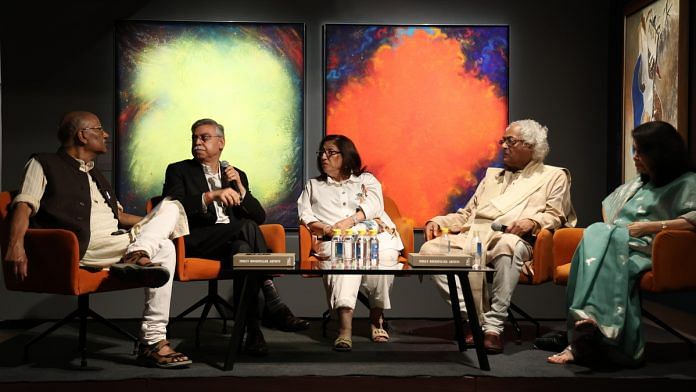New Delhi: The government’s revoking of tax exemptions on Indian art imported from other countries, rare works stuck in customs, and administrative hurdles are impacting paintings, procurements, and patronage.
“The state’s involvement in art has been very negligible. On the level of bureaucracy and state, we need more support and participation,” said Kiran Nadar chairperson of the Kiran Nadar Museum of Art at a panel discussion titled, ‘Patronage as Legacy’ at DAG, Delhi, on Tuesday.
The government’s role in the arts was the central theme of the discussion. And the main bone of contention was its decision to revoke a customs duty exemption on Indian art imported from abroad.
“We have reached out to the new culture minister, Gajendra Singh Shekhawat. He was not aware of this situation, and we are hoping necessary steps are taken,” said Nadar.
She wasn’t alone in her criticism of the government’s lack of knowledge and support of art procurement and promotion. Similar concerns were also voiced by several of the other participants—Sunil Kant Munjal, businessman and founder of Serendipity Arts Festival; Tasneem Z Mehta, managing trustee and honorary director of Mumbai’s Dr Bhau Daji Lad Museum; and Rajeev Sethi, chairman, Asian Heritage Foundation.
The session, moderated by ThePrint’s editor-in-chief Shekhar Gupta, was part of DAG’s exhibition ‘India’s Rockefeller Artists’, showcasing iconic works by Indian painters and sculptors who travelled to the United States of India with the help of grants. The exhibition runs until 12 October.
At first glance, government and art might seem worlds apart. But rules on taxation, provenance, shipping, and insurance can make acquiring art a cumbersome process. And that’s where governments step in to help keep a country’s cultural legacy alive.
“In India, though, state patronage is punctuated by bureaucratic hurdles,” said Tasneem Mehta.
A taxing ordeal for art
In his 2011 Budget speech, then Finance Minister Pranab Mukherjee announced a customs duty exemption for Indian antiquities and artworks brought back into the country. The caveat was that these works must be put on display for the public at exhibitions, museums, or galleries.
This exemption has prompted museums, both government and private, to actively seek out Indian artworks that had left the country and bring them back home. It’s a cumbersome process that can take months or even up to a year. Details of the art must be sent to the Ministry of Culture for approval and only after clearance can the pieces be imported.
But things just got more difficult for art importers. The government rescinded the exemption in a 6 September notification this year.
Nadar said this move came as a surprise.
“Last year, the culture ministry was asked to give their opinion on this tax exemption, which they did. Then the finance ministry responded that for the next two years, this exemption would continue,” said Nadar.
This, however, did not happen. According to Nadar, they received a memorandum on 11 September, dated 7 September, saying that the exemption has been reconsidered. This caused various troubles for the artworks already procured by museums.
“If we have to pay almost 25 per cent tax, including duty and GST, then it becomes very difficult to buy art items. Artwork brought in before this notification was sitting in customs, and we still had to pay the extra amount,” said Nadar.
Also Read: Art meets Ayodhya. NGMA, Lalit Kala Akademi are remaking India’s culture scene
‘Makes no sense’
All the panellists were on the same page about the challenges faced by patrons and museums alike in trying to procure art for the country.
“To pay tax for Indian art coming back makes no sense. Art is still in the hands of people who know less, and we are not coming together to oppose it,” said Asian Heritage Foundation chairman Rajeev Sethi.
The irony is that even government-funded organisations and museums are aware of these problems.
“There is no doubt that certain hurdles are created by bureaucrats, especially by those who have absolutely no knowledge of art,” said a spokesperson of the National Museum of India, which comes under the culture ministry. “But questionable behaviour goes both ways, both on the part of the government as well as private dealers.”
(Edited by Asavari Singh)






